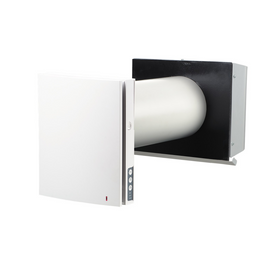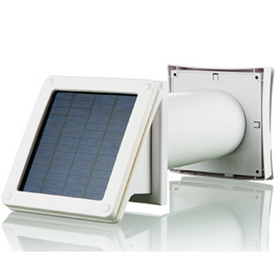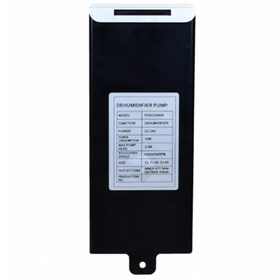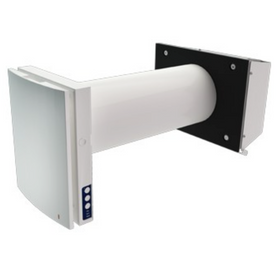
Does a House Need Ventilation?
Last Updated: Apr 13, 2025Is the solution to pollution always dilution? For the most part, yes, but not always. So when does ventilation of your house make sense? How much? For how long? Don't all the leaks in my home take care of this? I regularly get asked questions like these by clients when I am in their homes trying to make them healthier. Let's look at the problem and break down the solutions to fit the situations.
The Problems With Home Ventilation Systems
We do many things inside our homes, like breathing, cooking, showering, and laundry. Sure, they are all everyday things. When we do any of them, we generate moisture, odors, and particles that can negatively impact our overall indoor air quality. How so?
Even when we breathe, we exhale carbon dioxide (CO2). Too much CO2 in a room, like your bedroom with the door closed at night, can elevate the CO2 levels enough to impact your sleep patterns.
When cooking, we create moisture from boiling water and baking food, as well as particulates from frying our vegetables on the stovetop. We shower, bathe, and do laundry that generates a great deal of moisture within our homes. In some cases, this moisture can accumulate and even spur mold growth in specific locations. To have the best possible air quality in our homes, we need to understand the sources that negatively impact our health and the strategies to minimize them.
Mechanical Ventilation
Why do I need mechanical ventilation when my house is leaky? Excellent question - we want balanced air. We don't want to bring in air from leaky wall cavities and crawlspaces. I also get the opposite question: with all this energy efficiency stuff, will my house become too tight? It is a big challenge to get all the air sealing done in an existing house to make it really tight. But, if you invest in air-sealing at home, you will save a lot of energy and increase your home's resilience.
Once you do this, you'll need to ensure that you have point source moisture and odor removal and a mechanical ventilation system for the house. The Passive House standard, probably the tightest home building standard out there, requires mechanical ventilation to ensure your house doesn't make you sick.
Let's discuss the three types of systems, to help you understand more about mechanical ventilation. These are exhaust only, supply only, and balanced whole-house systems.
Table of Contents
- Sounds Great, What Could Go Wrong?
- What to Do With Your Existing Mechanical Ventilation System
- Bottom Line

Exhaust Only Ventilation
Exhaust only ventilation is, by far, the most common option and works best in cold climates. In this case, a home utilizes existing fans - think bathroom and kitchen fans - to pull stale air out of the house. If your home is relatively leaky, this option may be all you need. If your home is tightly sealed, as mentioned above, you could be pulling air from attics crawl spaces and other areas where air quality is not ideal. Heating and cooling costs can be increased with exhaust only ventilation, as you are sending your conditioned air outside continually.
Supply Only Ventilation
In this scenario, a homeowner would install a fan to bring outdoor air into the house. In contrast to the above option, this allows you to choose where the air enters the house. This method of ventilation is usually best in warm climates. However, without adequate moisture control, it can lead to mold and mildew issues as well as increased heating and cooling costs.

Balanced Whole House Ventilation
Energy recovery ventilators (ERV) and heat recovery ventilators (HRVs) are large boxes that typically hang in a basement near the furnace. These systems connect with two ducts for supply and return of inside air, and two ducts that go outside for fresh and stale air. For those without furnaces, these units have dedicated ductwork throughout the house, with fresh air supplies going to bedrooms and living rooms and exhaust sides going to the bathrooms, laundry room, and kitchen.
HRVs and ERVs offer the ability to pull stale, moist air out of the rooms that generate it, and supply conditioned fresh air to the spaces that benefit most from it. HRVs are typically installed in cold climates and smaller homes and ERVs in hot climates or larger homes. Although, with climate change, ERVs are becoming more predominant.
Both of these units are essentially fancy radiators: as the warm, stale inside air goes outside, it goes through a radiator. This energy warms the incoming cold winter air, preheating it before sending it through the house. It does the opposite in hot conditions, pre-cooling the incoming air. The main difference between the two units is that ERVs also take out and transfer a small amount of humidity. It's not enough to get rid of your dehumidifier or air conditioner, but enough to help. Because of the heat transfer that occurs with HRVs and ERVs, they avoid the waste of your warm indoor air in the winter and cool, conditioned air in the summer.
Sounds Great, What Could Go Wrong?
Similar to almost any mechanical system, the things that can go wrong happen upon installation and maintenance.
Poorly Installed Mechanical Ventilation
Unfortunately, these units are often installed improperly. The often forgotten critical step is that they need to be balanced. Meaning the inlet pressure needs to equal the outlet pressure. The installer does this by throttling the inlet and outlet valves and measuring them at low and high pressures to get them as close to each other as possible. The units come with stickers that go on the front stating the installation date, the installer's name, the low-pressure balance, and the high-pressure balance numbers. If there is no sticker or writing anywhere on it, then it wasn't installed properly. At best, the unit is wasting energy; at worst, it is sucking dirty air into the house.
Poorly Maintained Mechanical Ventilation
Did the installer mention you have to clean the inlet screen outside? Did they mention you have to clean the filters inside the unit? Both are necessary and super easy to do. If you don't clean them, then the inlet screen will clog up (which is relatively common). If this happens, you are no longer bringing fresh air into the home. If you have one, check them now and clean them off.
What to Do With Your Existing Mechanical Ventilation System
If you have an ERV or an HRV, have a look and see if it is balanced. If not, when you have your yearly mechanical inspection, have it balanced (you may need to ask for this ahead of time). Note that if the installer is not going around the house and turning on all exhaust fans and dryers, they are not doing it correctly.

Stephen Collette
Stephen Collette is a Building Biologist, Building Science Consultant, LEED Accredited Professional, and a Heritage Professional. Stephen is the owner of Your Healthy House and lives in Lakefield, ON with his wife and 2 daughters.











